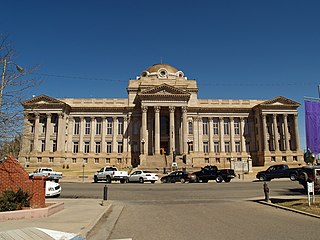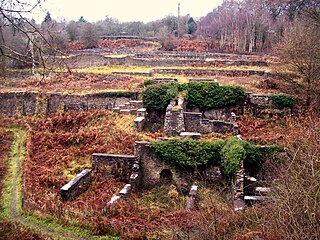
Pueblo is a home rule municipality that is the county seat and the most populous city of Pueblo County, Colorado, United States. The population was 106,595 in 2010 census, making it the 267th most populous city in the United States and the 9th largest in Colorado. Pueblo is the heart of the Pueblo Metropolitan Statistical Area, totaling over 160,000 people and an important part of the Front Range Urban Corridor. As of 2014, Pueblo is the primary city of the Pueblo–Cañon City combined statistical area (CSA) totaling approximately 208,000 people, making it the 134th largest in the nation.

Pueblo County is one of the 64 counties in the U.S. state of Colorado. As of the 2010 census, the population was 159,063. The county seat is Pueblo. The county was named for the historic city of Pueblo which took its name from the Spanish language word meaning "town" or "village".

Colorado State University–Pueblo (CSU–Pueblo) is a public university in Pueblo, Colorado. It is a member of the Colorado State University System and is a federally designated Hispanic-Serving Institution (HSI).

An ironworks or iron works is a building or site where iron is smelted and where heavy iron and steel products are made. The term is both singular and plural, i.e. the singular of ironworks is ironworks.
Founded in 1899, the Colorado and Wyoming Railway is a subsidiary of the Evraz North America. It hauls coal, ore and steel products on about five miles of track inside ERVAZ - Pueblo, CO Steel Mills facility in Pueblo, Colorado, and connects to the Union Pacific Railroad and the BNSF Railway. The railway used to be a much larger railroad, serving the CF&I's mills, steel plants that were the only vertically integrated steel mills west of the Rockies until World War II.

The Colorado Fuel and Iron Company (CF&I) was a large steel conglomerate founded by the merger of previous business interests in 1892. By 1903, it was mainly owned and controlled by John D. Rockefeller and Jay Gould's financial heirs. While it came to control many plants throughout the country, its main plant was a steel mill on the south side of Pueblo, Colorado and was the city's main industry for most of its history. From 1901 to 1912, Colorado Fuel and Iron was one of the Dow Jones Industrials. The steel-market crash of 1982 lead to the decline of the company. After going through several bankruptcies, the company was acquired by Oregon Steel Mills in 1993, and changed its name to Rocky Mountain Steel Mills. In January 2007, along with the rest of Oregon Steel's holdings, was acquired by EVRAZ Group, a Russian steel corporation, for $2.3 billion.

Peterson Air and Space Museum is located inside Peterson Air Force Base, Colorado Springs, Colorado. Admission to the museum is free, but access is controlled due to security concerns. The Museum has various aircraft, mainly focusing on the Cold War roles of USAF Air Defense Command (ADC), and Aerospace Defense Command (ADCOM)., and currently, Air Force Space Command (AFSPC).
Early coal mining in Colorado in the United States was spread across the state. Some early coal mining areas are currently inactive, including the Denver Basin and Raton Basin coal fields along the Front Range. There are currently 11 active coal mines, all in western Colorado.

The Minnequa Steel Works Office Building and Dispensary are historic buildings in Pueblo, Colorado. The main office building served as headquarters of Colorado Fuel and Iron Company. The medical dispensary building served as a medical clinic for treatment of minor injuries and illnesses, and in later years, as both clinic and personnel office for the Colorado Fuel and Iron Company. Opened in 1902, the six-room Spanish Mission style building contained waiting, drug, consultation, surgical and storage rooms, in addition to sleeping and office quarters for attending physicians. In 1902, as the company payroll exceeded 5,000 employees, the Dispensary handled an average of seventy-five cases daily. As employee numbers grew, medical staff also began treating families of employees. The building was used as a medical building for mill employees until the early 1990s. The Minnequa Steelworks Office Building, built in 1901, served as company headquarters until the early 1990s. Here, many office functions occurred including purchasing, finance, payroll, engineering, and other administrative functions. The building complex was listed on the National Register of Historic Places in 2002 and amended to the National Level of Significance of the National Register of Historic Places in 2008. Owned and operated by the Steelworks Center of the West, the medical dispensary building is the home of the Steelworks Museum of Industry and Culture, which opened on January 19, 2007. The museum's exhibits include the local history of coal mining, steel production, railroads, labor, and the impact of the Colorado Fuel and Iron Company on the region. The main administration building will serve as the second phase of the Steelworks Museum of Industry and Culture in the coming years.
Henry William Schneider was a British industrialist, and politician, who played a leading role in the development of the new town of Barrow-in-Furness.

Bessemer, Colorado was a city in Colorado that was incorporated in 1886. The community was named after Henry Bessemer, an English inventor. It was one of four adjacent towns settled after the Colorado Gold Rush of 1859. The communities of South Pueblo, Central Pueblo, Pueblo, and Bessemer were later merged to create the modern City of Pueblo, Colorado. Bessemer was an independent city until 1894 and was the last city to join Pueblo. The former community of Bessemer is sometimes now referred to as the Bessemer neighborhood. Its also known as the Bessemer area. The Bessemer area is home to both Bessemer Academy and Bessemer park.
Colorado Coal and Iron Company was formed in 1880 when three Denver and Rio Grande subsidiaries controlled by William J. Palmer merged. These were the Colorado Coal and Steel Works Company, the Central Colorado Improvement Company, and the Southern Colorado Coal and Town Company. In 1890 the company appointed Henry S. Grove President. Grove, a recognized "Captain of Industry" would eventually merge the company with the Colorado Fuel Company to form the Colorado Fuel & Iron Company, which for many years was Colorado's largest employer and dominated industry around the state for decades.

Darkhill Ironworks, and the neighbouring Titanic Steelworks, are internationally important industrial remains associated with the development of the iron and steel industries. Both are scheduled monuments. They are located on the edge of a small hamlet called Gorsty Knoll, just to the west of Parkend, in the Forest of Dean, Gloucestershire. Historically, Darkhill was sometimes written Dark Hill.

The Redstone Coke Oven Historic District is located at the intersection of State Highway 133 and Chair Mountain Stables Road outside Redstone, Colorado, United States. It consists of the remaining coke ovens built at the end of the 19th century by the Colorado Fuel and Iron Company. In 1990, it was recognized as a historic district and listed on the National Register of Historic Places.

John Cleveland Osgood was a self-made man who founded the Colorado Fuel and Iron Company but has been referred to as a robber baron. He also created Redstone, Colorado.
Morley was a town in Las Animas County, Colorado, that existed between 1878 and 1956. The town was located near the summit of Raton Pass and was originally a railroad stop before being developed into a coal mining town by the Colorado Fuel and Iron Company (CF&I). Morley was a CF&I company town for fifty years until 1956 when the mine was closed and the town demolished.

Sunrise was a company mining town of the Colorado Fuel and Iron Company located in Platte County, Wyoming. The entire site of the former mining district and town is on the National Register of Historic Places.

The Barrow Hematite Steel Company Limited was a major iron and steel producer based in Barrow-in-Furness, Lancashire, England, between 1859 and 1963. At the turn of the 20th-century and the Technological Revolution it operated the largest steel mill in the world.

The Darnall Works is a former steelworks in the Darnall area of Sheffield in England. The only remaining large complex of crucible furnaces, the works opened in the 1835 and were frequently extended and adapted until the late 20th century. Some of the structures at the works are listed buildings, at Grade II* and Grade II, and part of the site is a Scheduled Ancient Monument.

The Steelworks Center of the West, is a non-profit organization focused on preserving the history of the coal and steel industry in the Western United States. Based in Pueblo, Colorado and formerly known as the Bessemer Historical Society, which took its name from the community of Bessemer, site of the Colorado Coal and Iron Bessemer Works which was named after the Bessemer process for making steel invented by Henry Bessemer.














